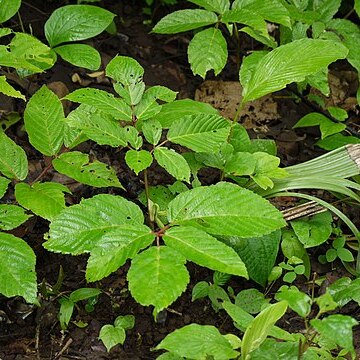Shrub, treelet or less frequently small tree up to 10 m, young branches usually densely hairy. Leaves 1-3-pinnate, leaflets 5 to numerous. Petiole (5-) 8-14 (-20) cm; stipules oblong-obovate, 1½-4½ by 3-6(-10) cm, pubescent to densely hairy, scar 1½-2½ (-4) cm long, slightly shorter than the stipule; rachis 7-20(-25) cm, petiole and rachis usually hairy. Leaflets ovate to ovate-lanceolate or elliptic to elliptic-lanceolate, (3-) 10-22(-30) by (1½-) 4-8 (-12) cm, above glabrous to hairy, particularly over the nerves, below sparsely to densely hairy, chartaceous; pearl glands globular to discoidal, brown, large and conspicuous to naked eye (in rare cases absent from the leaflets); margins serrate; apex acuminate to long acuminate; base cuneate to truncate, sometimes subcordate or unequal; nerves (5-) 8-14 (-18) pairs, usually densely hairy; petiolules 5-15 (-25) mm, hairy. Inflorescences 4-14 (-20) cm long, rusty pubescent to hairy; bracts ovate, up to 8 by 5 mm, conspicuous; peduncle 1-4(-8) cm, lateral and ultimate branches rather short, sometimes condensed. Flowers 5-merous, greenish white. Calyx 3-4 by 3-4 mm, glabrous to densely pubescent, usually with pearl glands; lobes 1 by 2 mm. Corolla tube + staminodial lobes 2½-4½ mm; corolla lobes 2-3½ by 1-1½ mm. Staminodial tube 1¾-2¼ mm long; upper free part 1½-2 mm, lobes deeply notched, sinuses shallow, to ½ mm; upper part 0.2-0.4 mm. Filaments 1-1¼ mm, anthers 1-1¼ mm. Ovary 4-7-celled, style 1½-2½ mm. Fruit 8-15 mm ø, orange-red, often drying pallid; seeds usually 5 or 6, 4-6 by 4-6 mm, rumination outline simple, endosperm simply ruminate.
More
A shrub or small tree. The small branches have ridges along them. They have rusty hairs. The leaves have 1 or 2 leaflets along the stalk. The leaf stalks have rusty hairs. The leaves are oval and 6-22 cm long by 3-7 cm wide. The fruit is 5-7 mm across and has 4-6 seeds.
Wide-spread, but scattered, in secondary vegetation, apparently rather rare in Malaya and Borneo, up to 1400 m but usually at lower altitudes.
More
Widespread but scattered distribution, in secondary vegetation from sea-level up to 1,400 metres, usually at lower elevations.
A tropical plant. It grows in forests and shrublands between 200-1,100 m above sea level in S China.

